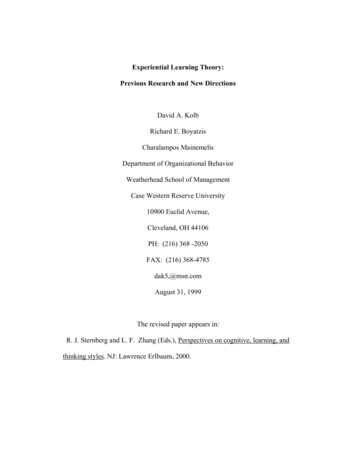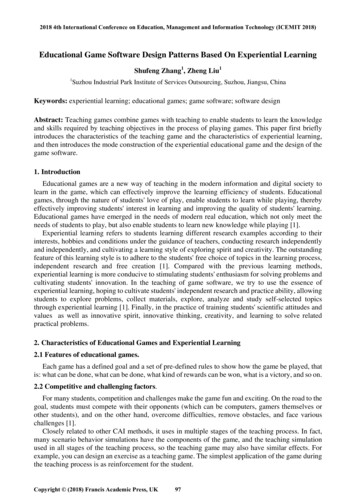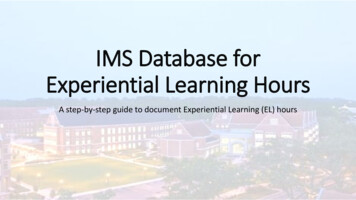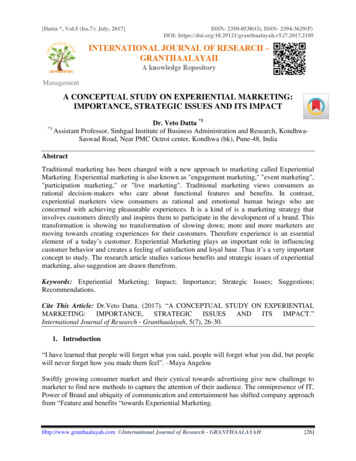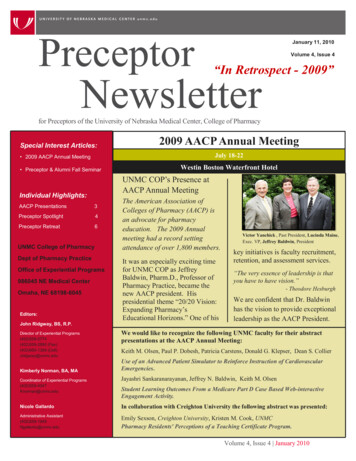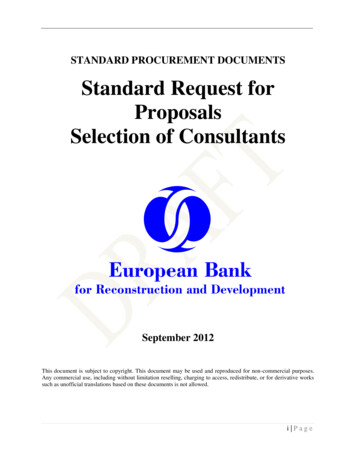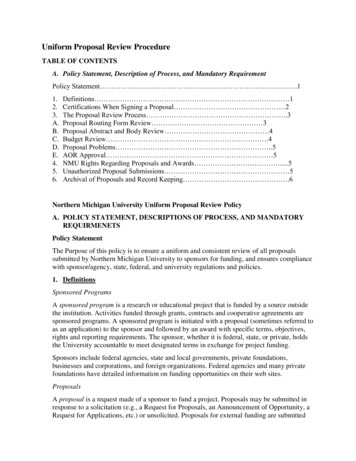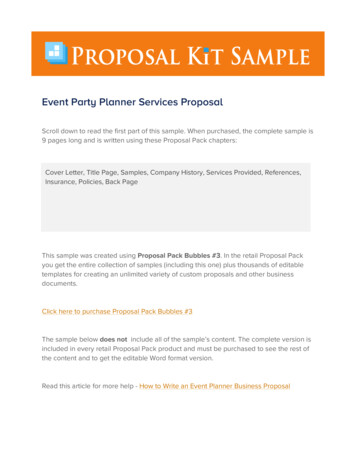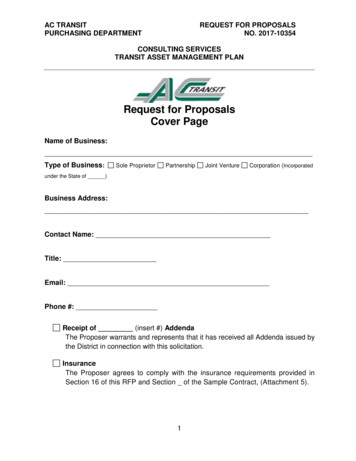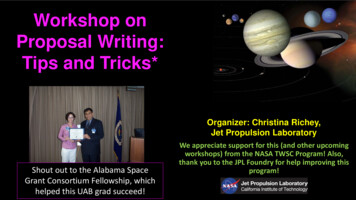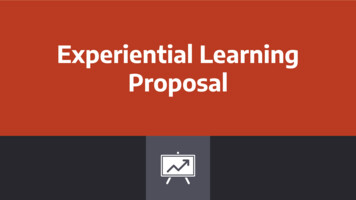
Transcription
Experiential LearningProposal
A PIVOTAL EXPERIENCEMy pivotal experienceWhat wasyours?Are you here because of a pivotal experience?2
STUDENT EXPERIENCES“I learned that I am capable of a lot more, professionally, than I thought I was, andthat setting goals is crucial to measuring growth.”Parker Smith, WOU CiP, Biology Online Teaching InternOn the verge of dropping out: “The people on those tripsbecame my community, which was what I needed . . . . Iloved being actively engaged, getting to see the directimpact of our work. It really helped me get a betterunderstanding of myself and of life”.Eli Cox, AB Honduras and India“I have enjoyed the experience of building a community project, being pushed to take on stronger leadershiproles with my group and with collaborating with other agencies to get our program implemented. Thank youfor . . . guiding the learning experiences and skill building opportunities in creative and useful practice.”Anonymous, David Foster’s EL Leadership class3
What would it look like if every student atWOU participated in EL?
If not all students participate,how do we decide who doesn’t get to haveExperiential Learning?
“Connecting students with communitiesthrough engagement in service, experientiallearning, creative problem-solvingopportunities and co-curricular collaborations.(Forward Together, Vision, page 2)6
WHY EXPERIENTIAL LEARNING EL is about social justice and upward mobility. Low income, first generation and URM benefit mostfrom EL. Need institution for cultural and social capital. EL is highly correlated with career readiness. It makeslearning real.7
““The interaction of knowledge and skills withexperience is key to learning”.“We do not learn from experience . . . . We learn fromreflecting on experience”.— John Dewey8
WHY NOW Increased affordability, enrollment and retention Social justice Strategic Plan General Education Program Accreditation Affordable training99
Strategic Initiative WOU is committed to personalized and transformativelearning; experiential learning epitomizes this mission All pillars in the strategic plan support the creation of an ELprogram, but the most prominent are: Community Engagement (1.1 – 1.3, 2.1 – 2.6)Student Success (1.1 – 1.3, 3.1 – 3.3, 4.4)Academic Excellence (1.2, 2.2, 2.4, 4.3, 4.4, 4.5, 5.1-5.4).Experiential Learning Strategic Action Team was formed
EL Strategic Action Team Rob Winningham, Provost – co-chairAdry Clark, Service Learning & Career Development – co-chairErin Baumgartner, Director of General Education Program, BiologyDavid Foster, Psychological SciencesAva Howard, BiologyLars Soderlund, EnglishKathryn Plummer, Service Learning & Career Development, ELErmie Buncal, International ProgramsGregory Zobel, Education & Leadership, Director, PURETeam is growing - Academic Affairs, Integrative Learning PLCMany possible partnerships, including FYS, Housing, Student Engagement1111
Building on Existing Programs PUREWOU Community Internship ProgramAlternative BreakStudy AbroadCareer MentoringLeadership CertificateService Learning & Career DevelopmentFaculty applying EL pedagogy1212
Outcomes Outcome1Affordability Outcome2Increased Enrollment Outcome3Increased Retention Outcome4Faculty has increased capacity – training & support Outcome5WOU has a definition for Experiential Learning Outcome6EL Practices are socially just Outcome7EL fte implements plan and initiatives
TIMELINE: Suggested by NSEE Faculty Exploratory Phase (Winter ‘17 - Fall ‘19)Input Phase (Spring ‘19 - Spring ‘21)Training and Capacity Building (Fall ‘19 - Spring ‘21)Formulate a task force or institutional structure tasked with establishingan EL program - White paper (Fall ‘20 - Fall ‘21)Program is established within three years (Winter ‘22)14
TIMELINE: This Year Up to now: Exploration - researching models, current practices, interest, need Training Fall 2018 - NSEE faculty EL WOU CiP intern, surveying and interviewing students, websiteComing up Spring 2019 Showcase Website with resources and updates1515
TIMELINE: Future Conferences - first for a designated team, NSEE fall ‘19, ELLI Spring ‘20.Seminars/development workshops, NSEE, ‘19 - ‘21Showcases and input gathering - first in Spring ‘19, approx. 2 per yearnext two years.Authorize a task force to write white paper and create a program, ’21Program operating in time for Integrative Learning ULO Capstone ‘2216
CONTINGENCY PLAN and JUSTIFICATIONFunding areaIf fundedIf not fundedFunding amount andcontingency optionsAffordability75 high need studentsparticipateHigh need studentsunable to participate 40,000No contingencyTraining andPilot ProgramsHigh quality EL capacityand expertise can bedevelopedNo change in capacityand expertise 18,000Faculty professionaldevelopment fundsProvost/DeansStudent Employmentand FTEFaculty/staff havesupport, initiatives areimplementedFaculty/staff lacksupport, initiatives maynot be implemented 25-73,000No contingency17
Defining EL at WOUNo one definition of experiential learning WOU needs to come up with its own definitionWhat we will create as a community will be unique to WOU and ourpopulation. It will be informed by best practice It will be equitable and affordable It will be sustainableThis takes time and fortitude to design and manage18
““WOU is approaching a large scale experiential learning initiative the rightway, with administrative support matched by authentic rigorous debatecoming from faculty and student affairs, who will be on the forefront ofimplementation.One of the most important things a university can do with high impactpractices and pedagogies is to ensure equity. It is easy for boutique programsto overlook the students who benefit from them the most.”Todd Petersen, NSEE Faculty, Executive Director of Experiential Learning,School of Engaged and Integrative Learning, Southern Utah University19
UBC Form: Phase2What type of Proposal is this? NewWill it require one-time funds? Or on-going funds? Both1. Requestor: Adry ClarkService Learning & Career Development503-838-8648 clarka@wou.eduAdditional Sponsors: Rob Winningham, Interim Provost, 503-838-8297, winninr@wou.edu Experiential Learning Strategic Action Team members:oAdry Clark, Service Learning & Career Development, 503-838-8648, clarka@wou.eduoDavid Foster, Psychological Sciences, 503-838-8805, fosterd@wou.eduoAva Howard, Biology, 503-838-8702, howarda@wou.eduoLars Soderlund, English, 503-838-8325, soderlundl@wou.eduoMaureen Dolan, Sociology, 503-838-8292, dolanm@wou.eduoKathryn Plummer, Service Learning & Career Development, 503-838-8041,plummerk@wou.eduoErmie Buncal, International Education and Development, 503-838-8508,buncale@wou.edu Erin Baumgartner, Interim Associate Provost, Academic Programs/Professor, Biology,503-838-8348 baumgare@wou.edu Becka Morgan, Computer Science, Chair, Integrative Learning PLC, 503-838-8964,morganb@wou.edu Gregory Zobel, Education & Leadership, Executive Director, Program for UndergraduateResearch Experiences, (PURE), 503-838-8728, zobelg@wou.edu Rob Findtner, Admissions, 503-838-8601, findtnr@wou.edu Tina Fuchs, Associate Dean Student Affairs Division, Dean of Students, Housing, 503838-8220, fuchst@wou.eduAdd Emily Lilo and other ExS faculty who worked with Todd Petersen2. Identify and justify the primary institutional priority that your initiative addresses:Community EngagementJustification:While the greatest impact will be student success, this requests most directly addresses prioryIII. Community Engagement. This proposal seeks funding to lay a foundation for accomplishingthe following initiatives:1.Enhance access to and support for experiential learning and cocurricular activities.1.1 Adopt experiential learning guidelines and align high-impact practices with these guidelines.1
1.2 Articulate internship or service learning opportunities for all academic programs.1.3 Develop experiential and co-curricular activities that provide appropriate accommodationsfor faculty, staff and students.2.Increase institutional engagement with local, regional and global communities.2.1 Increase support for student engagement in community service.2.2 Provide professional development for faculty and staff to promote engagement in communityservice.WOU’s mission is clear in its commitment to personalized and transformative learning;experiential learning epitomizes this mission. Experiential Learning also takes advantage of oneof WOU’s key advantages: low student-faculty ratios.All pillars in the strategic plan support the creation of an EL program, but outside of CommunityEngagement, the most prominent areoStudent Success (1.1 – 1.3, 3.1 – 3.3, 4.4)oAcademic Excellence (1.2, 2.2, 2.4, 4.3, 4.4, 4.5, 5.1-5.4)3. What are you proposing?We are proposing initiatives that support President Fuller’s goals for increased enrollment andretention, and will make transformative educational experiences more affordable to students.High Impact Practices (HIP) and Experiential Learning (EL) are highly correlated with retentionaccording to NSSE, and evidence shows prospective students are attracted to universities thatoffer hands-on learning. At the same time, the cost of participation in EL can be prohibitive tostudents and for programs to be effective, they require capacity and institutional support.EL is defined as learning from experience or learning by doing. Learners are immersed in anexperience and then encouraged to reflect about the experience to develop new skills, newattitudes, or new ways of thinking. Service learning, internships, research, independent study,creative projects and study abroad are examples. Offering effective EL requires capacitybuilding and thoughtful design. WOU is currently at the beginning stages of forming anaccessible experiential learning program, but lack of capacity, institutional and financial barriersto students, and lack of staffing prohibits progress. The Strategic Plan’s Values section commitsWOU to “Connecting students with communities through engagement in service, experientiallearning, creative problem-solving opportunities and co-curricular collaborations.” We proposeinvesting in initiatives that build on current programs, such as PURE and Alternative Break,develops faculty and staff capacity to design an experiential learning environment at WOU, andminimize barriers to student participation.In summer of 2018, Interim Provost, Rob Winningham, approved requests to fund bringing ELexperts on campus, who would help provide a framework for designing an EL environment atWOU. He also agreed to fund subsequent showcases and workshops. These efforts need to becomplemented by sending faculty and staff for more in depth training and for building incentivesfor EL pilot programs. Finally, WOU needs to start to build infrastructure to support EL effortsmore systemically.2
(If at all possible, I’d include some header here like) 3 Phase Funding RequestProposed one-time initiatives for funding - total 18,000:1.Send a small group of faculty and staff to an Experiential Learning Leadership Institute inUtah in June, 2019 (registration and travel 8,000)2.Create pilot EL programs for Fall, 2019 ( 10,000 for seed grants in 2019-20 AY budget)To make EL at WOU more affordable and increase access to EL, we propose the followingannual funding - total 40,000:1.Increase access to community engagement by providing 10,000 annually to run threeregional Alternative Spring Breaks2.Increase access to external internships: Provide 10,000 annually to augment InternshipFund, which provides competitive grants for internship3.Increase access to undergraduate research – Provide 20,000 annually for researchrelated travel, for Sophomores and Juniors to increase their engagement and investment inworking with WOU faculty.In order to facilitate EL efforts we request ongoing investment in labor and operation cost 73,000a. 8,000 for student labor to support Academic Excellence Showcase operations as well asexpanding PURE’s outreach to students through the year. Student work is more affordable thanthe 80-120 hours of labor current professional staff and librarians invest in helping make AEShappen.b. 2,000 administrative and outreach costsc. 63,000 for 1.0 fte Experiential Learning Program coordinatorTotal request 131,000.004. Who will benefit from your initiative?WOU Students will be the primary beneficiaries of our initiative. EL/HIP is highly correlated withretention (NSSE) and graduation, and our students will be enriched by the transformativeexperiences they will gain.WOU as an institution, will benefit from increase in enrollment as prospective students will beattracted to the hands-on opportunities, such as undergraduate research, internships, andservice. Students on Alternative Breaks or internships are often prominently featured inoutreach materials, in order to showcase WOU as a school with exciting opportunities to growand excel. Students participating in AES develop their professional knowledge, communication,and presentation skills. They also hone their scholarship. A strong EL program will make WOUstand out from other universities in Oregon and position it well, particularly with our target firstgeneration population, that might be attracted to applied experience that prepares them for3
careers and civic life post graduation.Faculty and staff will also benefit from building their capacity for rewarding, innovative andinterdisciplinary teaching and student development methods.The local and Oregon community will benefit from a well prepared workforce and engagedcitizenry of our interns, volunteers and graduates.4
* 5. LIST OUTCOMES AND DESCRIBE YOUR ASSESSMENT PLAN (link to directions):(i.e., how will you know if it worked? and how will you know if it didn’t work?)3900 characters remaining.To support the strategic plan, the President’s priorities of affordability, enrollment and retention,and the General Education Program’s goal of Integrated learning, the following measurableoutcomes guide this work:Outcome 1, AffordabilityOutcome 1.1 As a result of financial support for students to participate in EL, upwards of 75students will participate in high impact learning experiencesAssessmentNumber of new funding streams to support student EL participation and number of studentsparticipating in opportunities will increase: 10,000 for AB would allow three teams of ten students 30, or funds would providescholarship for students in need 10,000 competitive internship grant would allow 3-5 students to participate inmeaningful and high-profile internships in sectors that typically only offer unpaidinternships, such as art, science, entertainment and government/legislative 20,000 for research experiences and research related travel and conferences upwards of 40 students supportedAs a baseline, currently the only EL related funding stream available to students, is WOUCommunity Internship Program’s on-campus internships.Outcome 1.2 As a result of Integrating EL into required courses that count towards graduation,students have an accessible and affordable way to participate in ELThe number of courses that incorporate EL into curriculum increasesStipends for pilot programs will stimulate the development of more EL coursesAssessmentSurveying faculty participating in pilot programs and gathering further information in interviewswith faculty will help assess increase in number of opportunities and quality of pedagogy.(As a background, based on survey of faculty in 2017, EL integrated into courses is rare atWOU. Those who reported EL in courses used a definition of EL that was closer to activelearning than the definition provided).Outcome 1.3 A coordinated/interdivisional approach will create a systemic approach toenrolling more students in EL opportunities currently available, making EL affordable andaccessible to students.5
AssessmentDepartments and programs will track participation rate between current and future practice.Outcome 2, Increased EnrollmentHands-on and career readiness focus will appeal to first generation and low income students(and their parents), who also are interested in a enrolling in a liberal arts institution, increasingenrollment.AssessmentIncreased enrollment due to EL efforts might be hard to assess at this stage, but with pilotprograms and increased presence of curricular and co-curricular EL programs, some surveyingcan be conducted to gauge interest and impact on decision-making of students and theirparents.Outcome 3, Increased RetentionHigh impact experiences like EL is highly correlated with retention, as students find experiencemeaningful and develop greater sense of belonging at the institution.AssessmentWhile it may be hard to isolate EL as a cause for retention, statistical analysis of participation inAB and WOU CiP show significantly higher retention and graduation rates of students whoparticipate in these programs compared to the average WOU population.Qualitative assessment of participants shows many students decided to continue their WOUeducation because of their engagement with these programs.Similar studies can be conducted of participants in programs like PURE and study abroad.During the funded period, pilot programs can be similarly assessed.Differential effects of internships include gains in GPA, a predictor of retention. This could beeasily assessed if EL participation is tracked.Outcome 4, Faculty Capacity Will IncreaseOutcome 4.1 Faculty will have EL expertise, training in best practice and supportParticipation in current EL offerings will increaseAssessmentDepartments and programs will track increase in participation in the next three years.Outcome 4.2 Faculty gain EL capacity through training on and off campusAssessmentSurveys administered to faculty in 2017 and 2018 demonstrated lack of understanding, knowhow, and confidence in applying EL pedagogy. It also showed faculty has interest in training andin using EL as part of their courses.6
Faculty and staff who attended trainings by National Society for Experiential Education Faculty,last November, were surveyed to assess learning and interest. (see attached results)To assess the effectiveness of future trainings, follow up surveys, interviews and sharing oflearning will be facilitated.Outcome 4.3 Faculty have access to institutional supportAssessmentSurveys administered to faculty and staff in 2017 and 2018 demonstrated faculty need supportto effectively employ EL in their classrooms and programs, especially with communityconnections and logistics.Pilot program participants who receive experimental support will be interviewed to learn whatsupport was provided and what benefits and learning they gained from participating.Fte, such as EL Coordinator and student employees will provide administrative, logistical, andcommunity engagement assistance to facilitate EL activities and programs.Outcome 4.4 FYS and GenEd courses will incorporate best practice EL pedagogyAssessmentCourses will be assessed through interviews, assignment review, and learning communities onadherence to NSEE 8 Principles of EL and the EL initiatives in the strategic planOutcome 4.5 Integrative Learning courses are aligned with EL best practiceAssessmentCourses will be assessed through interviews, assignment review, and learning communitiesOutcome 4.6 Faculty reports greater satisfaction with more impactful pedagogy of ELAssessmentFaculty EL follow up surveyOutcome 5, WOU has a definition for Experiential LearningWOU currently does not have an official definition for EL, making conversations and goal settingproblematic.AssessmentWOU creates a definition of EL that is uniquely its own. An official recognition by the Presidentand a published statement would qualify as accomplishment of outcome.7
Outcome 6, Socially Just EL PracticesCurrent EL practices at WOU disadvantage students who lack social and financial capital.AssessmentTo assess for social justice, practices are assessed for accessibility, affordability, transparencyof process, and faculty/staff supportOutcome 7, Experiential Learning Coordinator will implement Task Force plan andinitiativesAssessmentTaskforce will outline specific plans, initiatives and outcomes that are tracked and monitored* 6. PROVIDE YOUR IMPLEMENTATION PLAN AND TIMELINE:The proposed timeline is informed by suggested steps from EEA faculty Patrick Clarke andTodd Petersen, who visited WOU and provided consultation and training in November, 2018.The timeline also draws on expressed need of faculty for capacity building. Some timelineevents overlap.General Timeline1. Exploratory phase - Spring 2017 - Fall 2019 - surveys of current practices, interest andcapacity, learning about models at other institutions2. Input by faculty, staff, students and community - Spring 2019 - Fall 2020 - showcases,focus groups, surveys3. Provide opportunities for training and capacity building on and off campus, includingshowcases, conferences, learning communities, pilot programs Spring 2019 - Fall 2021a. Off-campus trainings lead to on-campus training, showcases and moreopportunity for input.4. Formulate a task force tasked with establishing an EL program (We’re 2-3 squaresahead because of EL being so prominent in Strategic Plan). Task force hires ELCoordinator to implement plan and accomplish goals.a. Task force writes White Paper on creating an EL program at WOU5. Program is established6. Fortitude, fortitude, fortitude8
* 7. IF YOUR INITIATIVE IS NOT FUNDED, DESCRIBE YOUR CONTINGENCY PLAN:The EL Strategic Action Team has discussed a variety of possible scenarios for accomplishingthe EL initiatives of the Strategic Plan. While our ideal is listed above the following options willsome of the initiative.Focus on holistic approachOption 1 83,000, 40,000EL Student Affordability 18,000Faculty Capacity building (one time) 8,000Student Employment for implementing initiatives and current programs 2,000Administrative and outreach costs 15,000.20 faculty fte (replaces EL Coordinator)Option 2 68,000option 1, excluding .25 faculty fte. Process will be managed by EL SAT, then task force.Focus on faculty training/capacity buildingOption 3 25,000.00 a year for the next three years.Funds trainings, program development stipends, and a .25 faculty fte to coordinatedevelopment of academic EL program(s). Funds are overseen by Director of GeneralEducation program.This option does not address affordability for students and is focused solely onAcademic Affairs.Focul on Exploration and Capacity BuildingOption 4 10,000 seed money to be overseen by the GenEd Committee to foster and support study of ELon campus.Focus on AffordabilityFocus on StaffingOther Sources of FundingService Learning & Career Development staff has on numerous occasions pitched to WOUFoundation Board and Gift Officers to generate funding for EL efforts, such as Alternative Breakand internships. That effort has not been successful, thus far. This approach will still bepursued, but it is not a reliable source of funding. Efforts to find funding for an Americorpsposition to assist with EL have met with rejection.9
* 8. WHAT EXTERNAL AGENCY OR ORGANIZATION IS DOING SOMETHING SIMILAR?DESCRIBE WHAT THEY ARE DOING AND HOW YOUR PROPOSAL IS SIMILAR AND/ORDIFFERENT AND WHY:Not Applicable* 9. PROJECT ADVERSE IMPACTS, IF ANY (e.g., training required, extra workload,resource reallocation): (1) WHAT PRIMARY POPULATIONS AND/OR UNITS MAY BEUNFAVORABLY IMPACTED? (2) WHAT SECONDARY POPULATIONS AND/OR UNITSMAY BE UNFAVORABLY IMPACTED? AND (3) HAVE THE POPULATIONS/UNITS BEENCONSULTED?:Creating an EL program at WOU is something that will take fortitude to overcome severalchallenges. The greatest challenges are the following:1. Institutional resistance to holistic and systemic approaches and changes. The adverseimpact is temporary, especially if enough time and effort is spent on gathering input andgiving voice.a. A program that is division and program agnostic would be a new approach atWOU. We have a successful example of a systemic approach in the the GeneralEducation Program. That program, however, is strictly a Academic Affairsprogram.2. Initial workload on faculty and staff to learn about EL and design assignments, programsand assessmentsa. Some of this might be mitigated with training, stipends and course release.Perspectives might change after benefits of job satisfaction and strong outcomesare evident.3. Students perceiving EL as extra load.a. Students may lack awareness of EL as beneficial to their learning and careerreadiness, and therefore resist this effort. All depends on framing of concept andavailability of resources to assist.Over the next year, every stakeholder will be consulted using multiple methods, such as focusgroups, surveys, showcases, and division and senate meetings. For this program to besuccessful in the long run, it needs to reflect WOU’s unique culture, needs and resources.10
* 10. WHAT IS YOUR BUDGET JUSTIFICATION FOR THE RESOURCES REQUIRED?:(i.e., argue for the need of each component in the financial request/e.g., workforce, equipment,travel.)Affordability for StudentsTo make EL at WOU more affordable and increase access to EL, we propose the followingannual funding - total 40,000:1.Increase access to community engagement by providing 10,000 annually to run threeregional Alternative Spring Breaks2.Increase access to external internships: Provide 10,000 annually to augment InternshipFund, which provides competitive grants for internship3.Increase access to undergraduate research – Provide 20,000 annually for researchrelated travel, for Sophomores and Juniors to increase their engagement and investment inworking with WOU faculty.Training and staffing to develop capacity to deliver quality ELTraining - Proposed one-time initiatives for funding - total 18,000:1.Send a small group of faculty and staff to an Experiential Learning Leadership Institute inUtah in June, 2019 (registration and travel 8,000)2.Create pilot EL programs for Fall, 2019 ( 10,000 for seed grants in 2019-20 AY budget)these grants would go to faculty to develop new EL courses or new EL activities in theircourses. or did you intend something else?Staffing - Implementation - In order to facilitate EL efforts we request ongoing investment inlabor and operation cost - 73,000a. 8,000 for student labor to support Academic Excellence Showcase operations as well asexpanding PURE’s outreach to students through the year. Student work is more affordable thanthe 80-120 hours of labor current professional staff and librarians invest in helping make AEShappen.b. 2,000 administrative and outreach costsc. 63,000 for 1.0 fte Experiential Learning Program coordinatorTotal request 131,000.00You will upload your Budget Spreadsheet on the next page.11
12
What type of Proposal is this? New Will it require one-time funds? Or on-going funds? Both 1. Requestor: Adry Clark Service Learning & Career Development 503-838-8648 clarka@wou.edu Additional Sponsors: Rob Winningham, Interim Provost, 503-838-8297, winninr@wou.edu Experiential Learning Strategic Action Team members:
